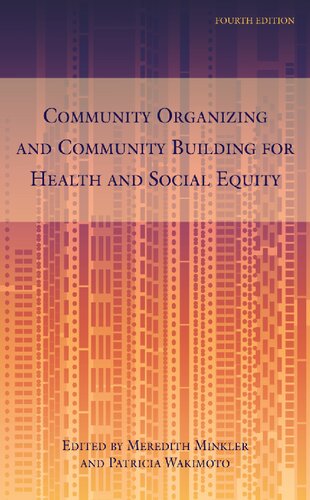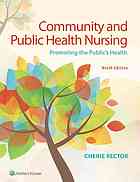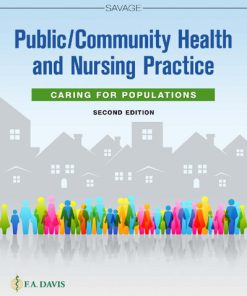Community Organizing and Community Building for Health and Social Equity by Meredith Minkler 9781978824768 1978824769
$50.00 Original price was: $50.00.$25.00Current price is: $25.00.
Community Organizing and Community Building for Health and Social Equity Meredith Minkler – Ebook Instant Download/Delivery ISBN(s): 9781978824751, 9781978824744, 9781978824775, 1978824750, 1978824742, 1978824777, 9781978824768, 1978824769

Product details:
- ISBN 10: 1978824769
- ISBN 13: 9781978824768
- Author: Meredith Minkler
The fourth edition of Community Organizing and Community Building for Health and Social Equity provides both classic and recent contributions to the field, with a special accent on how these approaches can contribute to health and social equity. The 23 chapters offer conceptual frameworks, skill- building and case studies in areas like coalition building, organizing by and with women of color, community assessment, and the power of the arts, the Internet, social media, and policy and media advocacy in such work. The use of participatory evaluation and strategies and tips on fundraising for community organizing also are presented, as are the ethical challenges that can arise in this work, and helpful tools for anticipating and addressing them. Also included are study questions for use in the classroom. Many of the book’s contributors are leaders in their academic fields, from public health and social work, to community psychology and urban and regional planning, and to social and political science. One author was the 44th president of the United States, himself a former community organizer in Chicago, who reflects on his earlier vocation and its importance. Other contributors are inspiring community leaders whose work on-the-ground and in partnership with us “outsiders” highlights both the power of collaboration, and the cultural humility and other skills required to do it well. Throughout this book, and particularly in the case studies and examples shared, the role of context is critical, and never far from view. Included here most recently are the horrific and continuing toll of the COVID-19 pandemic, and a long overdue, yet still greatly circumscribed, “national reckoning with systemic racism,” in the aftermath of the brutal police killing of yet another unarmed Black person, and then another and another, seemingly without end. In many chapters, the authors highlight different facets of the Black Lives Matter movement that took on new life across the country and the world in response to these atrocities. In other chapters, the existential threat of climate change and grave threats to democracy also are underscored.
Table contents:
PART ONE: Introduction
1 Introduction to Community Organizing and Community Building in a New Era
2 Why Organize? Problems and Promise in the Inner City
PART TWO: Contextual Frameworks and Approaches
3 Improving Health through Community Organizing and Community Building: Perspectives from Health Education and Social Work
4 Anti-racism Praxis: A Community Organizing Approach for Achieving Health and Social Equity
5 Contrasting Organizing Approaches: The “Alinsky Tradition” and Freirian Organizing Approaches
6 It’s All Organizing, It’s All Love: Building People’s Power in Jackson, Mississippi
PART THREE: Building Effective Partnerships and Anticipating and Addressing Ethical Challenges
7 Community, Community Organizing, and the Forming of Authentic Partnerships: Looking Back, Looking Ahead
8 Ethical Issues in Community Organizing and Capacity Building
9 Communities Driving Change: A Case Study from King County’s Communities of Opportunity
PART FOUR: Community Assessment and Issue Selection
10 Community Health Assessment or Healthy Community Assessment: Whose Community? Whose Health? Whose Assessment?
11 Mapping Community Capacity
12 Selecting the Issue
PART FIVE: Community Organizing and Community Building within and across Diverse Groups and Cultures
13 Education, Participation, and Capacity Building in Community Organizing with Women of Color
14 Mobilizing Black Barbershops and Beauty Salons to Eliminate Health Disparities: Lessons Learned on the Road to Health Equity during a Global Pandemic
15 Popular Education, Participatory Research, and Community Organizing with Immigrant Restaurant Workers in San Francisco’s Chinatown: A Case Study
PART SIX: Using the Arts and the Internet as Tools for Community Organizing and Community Building
16 Creating an Online Strategy to Enhance Effective Community Building and Organizing: Harnessing the Power of the Internet
17 Using the Arts in Community Organizing and Community Building: An Overview and Case Studies
PART SEVEN: Building, Maintaining, and Evaluating Effective Coalitions and Community Organizing Efforts
18 Community Coalition Action Theory: Designing and Evaluating Community Collaboratives
19 Addressing Food Insecurity and Tobacco Control through a Neighborhood Coalition: Applying Community Coalition Action Theory and Principles for Collaborating for Equity and Justice
20 Funding for Community Organizing: Tips for Raising Money While Promoting New Thinking in the Funding Environment
21 Participatory Approaches to Evaluating Community Building and Organizing for Community and Social Change
PART EIGHT: Influencing Policy through Community Organizing and Media Advocacy
22 Moving the Policy Dial through Equity-Focused Community Organizing
23 Abolition as a Public Health Intervention: Building Multisector Momentum for Community Care and Criminal Legal System Policy Change
24 Media Advocacy: A Potent Strategy for Engaging Communities in the Fight for Equitable Public Policy
Appendixes
1 Challenging Ourselves: Critical Self-Reflection on Power and Privilege
2 Community Mapping and Digital Technology: Tools for Organizers
3 Action-Oriented Community Diagnosis Procedure
4 Sample Community Health Indicators for Use in Health Impact Assessment
5 Skywatchers’ Values-Based Methodology and Guidance for Practice
6 Ladder of Community Participation in Public Health
7 Member Assessment of Coalition Process and Outcomes
8 Issue-Development Worksheet
9 Choosing Tactics and Framing the Action: Key Questions and Considerations for Getting It Right
10 Engaging Coalition and Community Organization Members in a “River of Life” Exercise to Create a Historical Timeline
11 Using Force Field Analysis, SWOT Analysis, and Power Mapping as Strategic Tools in Organizing
12 Scale for Measuring Perceptions of Control at the Individual, Organizational, Neighborhood, and Beyond-the-Neighborhood Levels
People also search:
community organizing and community building for health and welfare pdf
what is community organizing
community organizing examples
community organizing/building and health promotion programming
community organizing principles
You may also like…
Politics & Philosophy - Social Sciences
Community Practice and Social Development in Social Work Sarah Todd
Psychology - Psychotherapy
Medicine - Nursing
Community & Public Health Nursing 3rd Edition by Demarco 1975111699 9781975111694
Medicine - Medicine & Nursing Test Prep
Politics & Philosophy - Social Sciences
Corporate Social Responsibility and Community Development Ainur Rochmaniah.
Medicine - Medicine & Nursing Reference












